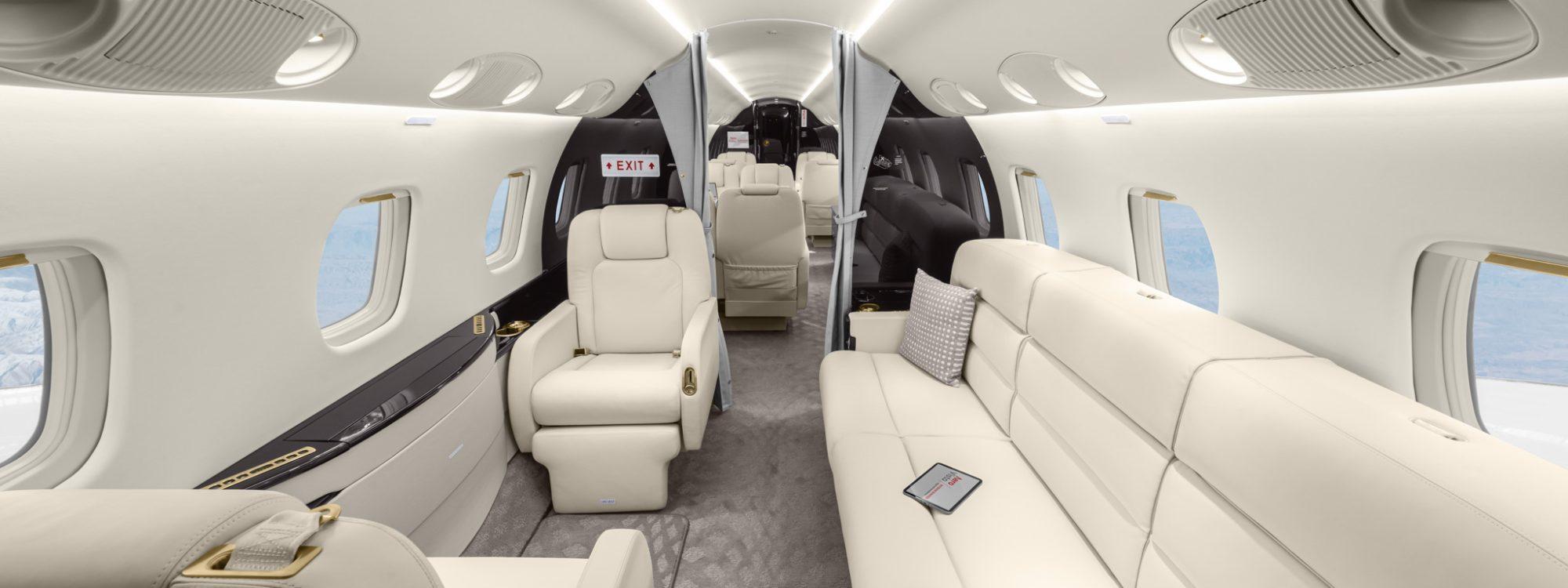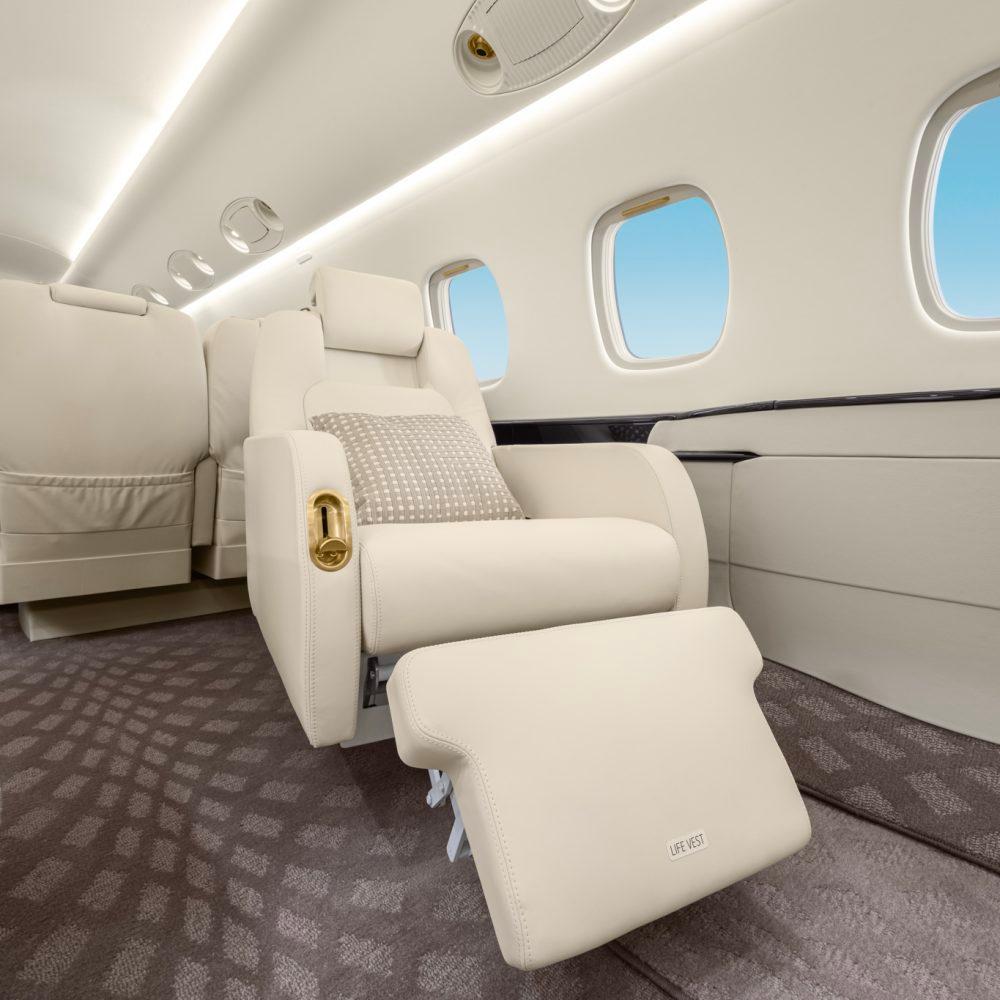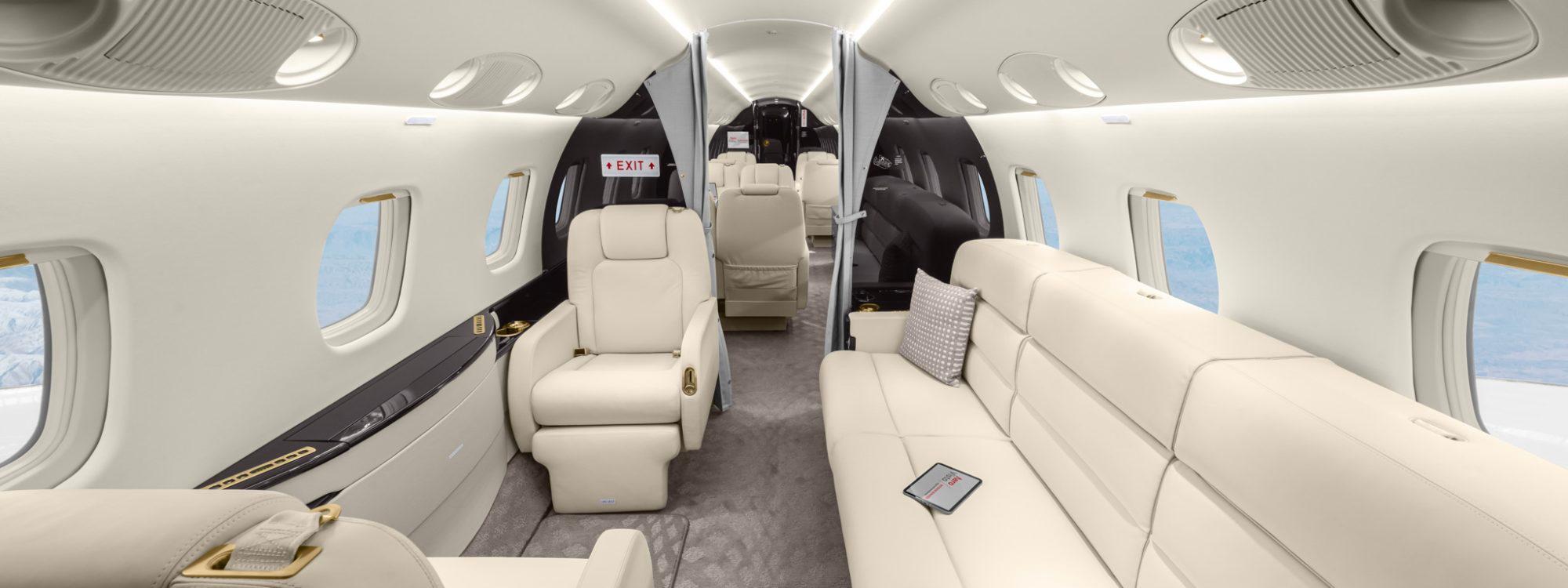












revival of an airplane preserving existing values and resources
sales lead AeroVisto interior design AeroVisto use case government aircraft cooperation



The shapes of the passenger seats, the divan and the compartments, remain in line with the OEM design And yet the cabin looks surprisingly new and different. This is partly due to the timeless look and feel of the new design with an elegant light dark contrast All upholstery parts have been covered in light colored leather The surfaces have been given a dark high gloss veneer.
Sometimes you don’t see an object’s amazing history at first glance That is also the case with this Embraer Legacy 600. What you see here is a success story in which dedication and skills have succeeded in preserving existing values and reactivating valuable resources for operational use.This business jet, which operates in the service of the Nigerian government, had to endure a very long downtime before it was once again allowed to carry passengers across the skies in its new splendor.
timeless look & feel with an elegant contrast
The headrest of a passenger seat is decorated with the state coat of arms of Nigeria. With 6 colors, very filigree elements and lettering on a colored background, only a special screen printing process came into question for the realization of this customer request. This small but outstanding detail is another great example of the high degree of individualization that can be achieved thanks to innovative solutions in refurbishment.

The leather for the passenger seats and the Divan was made entirely to the customer’s specifications smooth and nappa like, without grain, in an individually matched beige color And to achieve the wanted contrast, the existing reddish veneers were tinted dark before revarnishing. A special eye catcher of the interior is the new carpet made of New Zealand wool Its asymmetrically running diamond pattern brings an additional subtle swing to the classic elegance of the cabin.



a small but outstanding detail
This Embraer Legacy 600 is a real success story. An aircraft that had been in an uncontrolled environment for 8 years has been restored to active operation.



This shows that determination, professional skills, coupled with good communication and coordination can contribute a lot to preserve existing values and to sustainably using existing resources a real success story.

Passenger seats and divan upholstery with stay clean leather technology



Special screen printing of the state coat of arms on the headrest
Refurbishment of all wooden parts by tinting and revarnishing
Headliner, windowliner, valance panels, dado panels and sideledge upholstery
Carpet replacement in entrance & galley, cabin and aft lavatory

Replating of all parts
Mirror replacement
Production of main entrance and cabin curtains
Jetlag is extremely disruptive. Not only do you have a long journey to contend with, you then have the difficulty of adjusting your circadian rhythms to the new time zones when you land. When this difference is more than four hours different from your original time-zone, it can dramatically impact your productivity and functioning.
The effects of jetlag go far beyond feeling groggy and disoriented during the first few days of a trip. Prolonged jetlag can have serious impacts on productivity, physical wellbeing, and mental health. When our body's internal clock is thrown off balance, it can be difficult to concentrate and perform at our usual level. This can lead to missed deadlines and dropped projects, causing strain in both personal and professional relationships.
For example, a recent study showed that circadian rhythm disruption is closely associated with neuropsychiatric disorders, such as ADHD (attention deficit disorder). This often displays itself not just as an inability to focus and concentrate, but also in poor decision making and impulsivity, and has been described as “social jetlag”. Likewise, a productive, efficient executive can find their performance is dramatically (albeit temporarily) reduced when they’ve had a disruptive flight.
Negotiating a complex business contract can be challenging, even for the most experienced executives operating at peak performance. With so many specific details and potential risks to consider, it is easy for important points to be overlooked or misunderstood. And if you aren't in top form, your ability to negotiate effectively can suffer even further which can have serious consequences, including missed opportunities and huge financial losses.
The extent of this financial impact should not be underestimated. A 2016 study showed that jet-lag cost UK companies $337 million (£241 million) a year through mistakes made by jetlagged staff. This figure is taken from the workforce at all levels, including junior level employees with limited responsibility. When we direct our focus to top-tier executives: the owners, board members and decision makers, the financial effects become far more significant to our businesses and, indeed, the economy as a whole.
It's easy to believe that jetlag is a personal issue, a matter of feeling “under the weather” and it can be easy to overlook the wider ramifications. However, when you’re operating at VVIP levels, an inability to concentrate or a single bad decision can hit the value of your company’s shares and reduce dividends, which impacts your investors and your fellow board members, and could potentially cause financial difficulties for hundreds of employees.
Knowing the weight of your decisions is why your time is so highly valued. As an executive, you always strive to be at the top of your game during negotiations and alert for any challenges that may arise. As such, safeguarding your physical and mental wellbeing in order to work effectively becomes a responsibility to the people who depend on you. Jetlag, therefore, isn’t just a mild inconvenience, it’s a real problem that must be addressed and reduced as much as possible for the benefit of everyone around you.
Put simply, you need to be able to manage the factors that disrupt your body’s circadian rhythms. This means finding schedules and accommodations that ease you gently into a new time zone: well-rested, well-fed and comfortable, able to work at peak effectiveness the moment you touch the ground, or even during the flight. Obviously, commercial travel is only viable by corralling lots of people into a small area and asking them to board, eat and sleep at the same time. It’s cost efficient but comes at the expense of individual needs, causing discomfort and jetlag for passengers.
However, when the stakes are higher and a passenger has a wider responsibility to perform at their best, that cost-efficiency becomes a false economy. Individualised travel is the only way to go – and the more you can customise your travel, the more you can minimise the impacts of jetlag. Private jets allow you an unparalleled ability to manage your environment and create an ecosystem that supports your needs and those of your business.
When it comes to traveling, time is precious. The ability to choose your own schedule without being beholden to commercial flight times can be crucial for those with demanding work and personal schedules. This is where owning a private jet truly shines. Chartering a plane still requires planning ahead and often comes with rigid cancellation policies, but owning a jet means that you have the ultimate flexibility in terms of when and where you want to travel. No more scrambled last-minute changes or missed opportunities due to limited flight options
– you have control of your own schedule. If you want to sleep on a night flight you can arrive at your destination refreshed and ready, or you can fly during the day and spend the time productively, arriving fully prepared for a critical meeting, it’s entirely your choice.
And, critically, flying privately means you only need to account for a very short time at the airport - no struggling through crowds or multiple security checks means you can arrive as little as 15 minutes before departure. Likewise, on arrival, you’ll clear customs and NEVER lose a bag, which means you can be heading for your next appointment within minutes.
When it comes to your environment during the flight, there’s absolutely no comparison between private aircraft and flying commercial - you’re not crammed into a small space with hundreds of other people and the massive effect that has on air-quality and background noise. Flying privately, you don’t have to deal with other people and the cabin is spacious and well-lit, with plenty of room to move around.
Furthermore, owning your own aircraft allows you to customise your surroundings and create an oasis of peace and tranquillity - a level of comfort that can’t be matched by flying charter. Some jet-owners prefer bright and dynamic décor that energises them, whilst others might find this nerve-jangling and stressful. One person’s calm, soothing space may feel bland and lacklustre to another. These jets for hire will be outfitted to provide the least discomfort for the widest amount of people but can’t provide the same bespoke surroundings that you can experience by designing your own environment. We discuss some of what’s possible in interior aircraft design in our article here.
Another often overlooked aspect of jetlag and physical discomfort is cabin pressure. The New England Journal of Medicine has published research showing that oxygen saturation in a person’s blood decreases with increasing altitude, and physical discomfort was reported more at altitudes over 7,000 feet than at lower altitudes. Long flights at a higher altitude resulted in symptoms seen in mountain sickness: headache, nausea, fatigue, aching and cramps. Commercial aircrafts are pressurised to 8,000 feet, whereas private jets are pressurised within a range of 4,000 to 5,000 feet – not only providing a much more comfortable flight, but also reducing the risk of more severe symptoms. For example, there is some evidence showing that a higher cabin pressure might reduce the risk of thrombosis.
It’s thought that lower cabin pressures make it easier for blood to pool in the veins and arteries, which can lead to clotting. While there is no guarantee that a higher cabin pressure will prevent thrombosis, growing amounts of information suggest that it may reduce the risk.
In addition, some private aircraft have humidification systems which increases your level of comfort by reducing the problems associated with dry air: red eyes, sore throat and dry skin. Improving hydration further reduces the stress of travel and symptoms of jetlag, increasing wellbeing and productivity.
Another factor in addressing dehydration and reducing jetlag is the catering available on private jets.
It’s known that eating at different times affects your metabolism in different ways. The body has a natural circadian rhythm for blood sugar concentration, meaning that if you ate consistent small snacks instead of occasional standard meals, your blood sugar would still change over the course of the day. Similarly, eating an evening meal results in a higher peak of blood sugar and fat concentration than eating in the morning.
When flying on a private jet, you have the benefit of being able to personalise catering to suit your needs. This means that if you're trying to adjust to a new time zone, you can easily change your eating schedule to help you stagger your meals and make the transition smoother.
As well as eating at the right time, it’s important to consider what you eat during your flight. For example, in Reader’s Digest, a dietitian recommends eating light, good-quality meals with a good balance of protein, complex carbohydrates and plant-base fibres which won’t weigh you down or make you feel nauseous.
A personal chef and a professional designed galley can provide you with fresh, delicious meals that are cooked on demand and tailored to your individual needs. Having a consummate professional understand your culinary preferences and the effects of air-travel means you can eat nutritious and delicious meals made with goodquality, fresh ingredients when it suits you - not when it’s convenient for the staff.
Essentially, the ability to eat what you want, when you want to eat is critical for reducing mental fatigue and is critical in supporting your well-being, allowing you to remain productive and clear-headed. Not only that, it’s a million miles away from being asked “would you like the chicken or the pasta?”
The effects of stress on the human body is well known and the financial costs can be huge. The World Health Organization estimates that stress costs the global economy nearly US$ 1 trillion yearly. As such, it's not possible to maintain peak performance without incorporating down-time. When you're making complex decisions with wide-reaching consequences, stress can build up and reduce your performance by impairing your judgement and making you feel physically ill. No matter how dedicated you are to your work, it's essential you have time to decompress and recharge to keep a clear head and return to work feeling energised and ready to tackle issues head on.
Having access to your favourite music, TV shows, or movies can help you unwind and make the trip more enjoyable and with your own private jet, you’ll have entertainment options that meet your requirements. Possibilities include an entertainment system showing great movies and tv shows, an audio deck for your favourite tunes, a gaming rig or all of the above. A dedicated space for a fully-equipped home theatre with surround sound with perfect high resolution video, all viewed from a very comfortable front-row centre seat is the perfect way to switch off if you’re starting to lose focus. You may feel guilty when you don't spend every moment reviewing data or preparing for contract negotiations but taking a couple of hours to focus on self-care is a more productive use of time than being burnt out and potentially second-guessing a good decision.
The biggest issue with jetlag is the loss of sleep. Not only do you have fatigue from the journey but the speed of travel means your body is unable to process the change of time zones quickly enough to allow you to be productive and clear-headed shortly after you’ve landed.
After a long-haul flight, you can find yourself talking to energised clients at a time when you’d normally have been asleep for several hours. Without being able to adapt rapidly, it’s impossible to keep up. The CDC recommends that if you are traveling to a time zone that is more than 3 hours different than your normal time zone you should follow the sleep and waking routines of your destination when you arrive. But if your destination time-zone is more than 8 hours ahead, you could find yourself having to stay awake for 24 hours straight in order to begin the reset process.
Even then, you’re likely to wake up too early and feel groggy, which will noticeably impair your performance in a high-stakes environment. Common advice for reducing jetlag is to sleep on the aircraft wherever possible, as this allows you to start adjusting to your new time zone. However, the success of this is very dependent on the quality of the sleep you manage to get. You may be able to lie flat in Business Class but you have no control over the noise, your neighbour, lighting, privacy or the environment in general.
For a top-level executive, good-quality sleep is absolutely critical for good judgement and focus. Sleeping options on board a jet can vary wildly, from reclining seats, through to private luxury bedrooms, depending on the type of aircraft. In Part 2, we’ll concentrate on sleep as part of jetlag, and explore sleeping options aboard charter and private jets.



Flying connects people, cultures, countries and enables us to cross borders. But we pay a high price for our dream of flying come true.
A fully loaded aircraft with luggage and a small amount of cargo in the hold, fully fuelled for the flight - this cannot go hand in hand without consuming a lot of energy. Unfortunately, this is not yet possible without emissions. Aircraft produce greenhouse gases, noise and air pollutants. In addition to the emission of CO2, it is above all the emission of nitrogen oxides and the generation of contrails and the associated change in cloud formation that have a detrimental effect on the climate. The special thing about flying: it happens at high altitudes. There, many substances have a completely different effect than near the earth's surface. Studies by various institutions come to the conclusion that the share of CO2 emissions from aviation in global CO2 emissions is about 3.5 per cent.
The industry is aware of these fatal consequences and there is no question that aviation must become more sustainable in times of climate change. Nevertheless, aviation is an essential part of today's functioning global economy. Current studies assume that the volume of transport and passengers in the aviation sector will grow strongly in the coming years and thus also the relevance of aviation to the environmental impacts in the transport sector. It is therefore also a fact that hardly any other industrial sector has set itself such ambitious goals as air transport. The European Union wants to make air traffic climate-neutral by 2050. To achieve this socalled Clean Aviation, aeroplanes should not only be fuelled with bio-kerosene. New aircraft generations are also already in the starting blocks - sustainably produced, with reusable components and powered by electricity or hydrogen.
So the obvious problem catches the eye right away. But inextricably linked to this are the services around the aircraft, which can also make a positive contribution to more sustainable aviation. Not only aircraft operators, but also service providers can reduce the ecological footprint. Compared to long development cycles of sustainable fuel, this goal can be achieved well in the short term.
CO2 emissions can also be further reduced and optimized in ground handling. Every ride of the passenger bus or towing vehicle means CO2 emissions, air pollution and noise. Through optimized route planning, however, ideally fewer vehicles can travel shorter distances. More and more airports are also turning to vehicles with electric and hybrid drives. In addition, parked aircraft switch off their auxiliary power units for power supply on the ground and use a ground power unit through mobile gensets. In many places, these are already powered by solar energy. Moreover, the goal of a circular economy is already being tackled by many. Over time, procurement and transport costs of new materials, dependence on third parties and costs for energy and disposal of waste decrease.
PRIMUS AERO is also aware of its responsibility. For some years now, our company car fleet has been purely electric. Currently, our fleet includes more than 10 electrically powered vehicles, which means that the CO2 emissions of our team members are zero. But even for products that do not necessarily have to do with our main business, we pay attention to regionality and short delivery routes. We buy Christmas presents for our customers from local producers, for example, and make sure that they use plastic-free packaging wherever possible. The same applies to print media, promotional gifts, business cards and notepads from our company.

But our biggest project is still to come: we are moving! Our new offices are much more energy-efficient and sustainably equipped. The building is a replica of the Saubermacher AG office complex. The climatefriendly headquarters brought the Austrian company the State Prize for Environmental and Energy Technology in 2012.
In summary, it can be said that international air transport still has some challenges ahead of it until CO2-neutral flying is achieved. SAF, the gamechanger for many, is currently hardly available and up to nine times more expensive than paraffin from fossil sources. But almost all airlines are convinced of its future potential - so it is only a matter of time. However, attention should not only be paid to the further development of aircraft. Smaller investments can also cause big changes. After all, small steps are also steps in the right direction.
Whataboutmodifyingyouraircraft?Newavionics or a medical stretcher installation? New requirements may need an upgrade on your current aircraft systems But do you know all the differentsolutions?
Whatyouhadtoresearchandspendalotoftime looking for the right solution will become much faster!
With our new STC section filtered for your aircraft type,youhaveallSTC'sinonespot!Thatwillmake yourresearchsomuchfaster Insteadofspending time on research, you can go to the supplier and discussthebestoption
WithourMROnetwork,youcaneasilyfindtheright MRO to install your STC Easy and fast and you havemoretimeforotherprojects
Together with our Knowledge Blog with many topics about various topics for the technical managementofyouraircraftyoucanmasterthe upgradewithease.


IfyouareasupplierofSTC'sfeelfreetocontactus tohaveallyouSTC'ssetupinourdatabase
Formoreinfocontact
AndreasPast a.past@aviationheaven.com
Pro Star Aviation, an innovative special missions aerospace modification center, announced today, in partnership with CNC Technologies, that they have delivered the fifth high tech special mission Cessna 208CaravanthatCNCdeliveredtotheTexasDepartmentofPublicSafety.
The FAA is giving out grants totaling more than 16 million dollars (US) to reduce aviation emissions and noise Fourteen universities will be receiving the funds and conducting research for several types of sustainableaviationfuels,propulsion,andnoisereduction.


Demandforaviationlubricantsisrisingduetoincreasedtravel MRO|AviationWeekNetworkreportson theriseforoils,greases,andmorehere:
An uncommanded flap-extension incident is still being investigated, as reported by Flight Global. The Challenger604hadhadslowflapretractionbeforetheincident Readmorehere:


Abigthanksgotoourpartners.Withoutthem,itwouldhavenotbeenpossibletohave createdsuchahugeplatform.Weareveryproudtohavesuchstrongcompanies amongourpartners.



